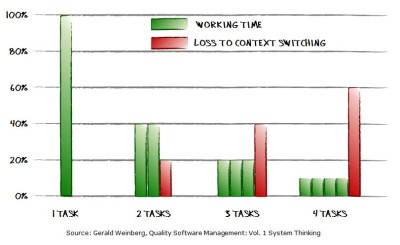There’s one question I ask pretty frequently during my presentations or trainings: do you think that context switching comes for free? I’m yet to see a single hand up after the question.
Not that I believe that this is universally accepted point of view. In fact, there is a follow-up question which is: who has a boss who thinks that context switching comes for free? I do get positives for the latter.
I’d also assume that some people, even if they believe in free context switching simply wouldn’t raise their hands. Peer pressure, you know.
I’m happy with the assumption that awareness of costliness of context switching isn’t ubiquitous and definitely there are different assessments of how costly it is exactly. Still, I’d say that basic understanding that we pay a context switching tax is pretty common.
After all, it oh so obvious to predict how texting on the mobile while walking through a crowded street is going to end. Or playing Angry Birds while driving. Or driving, having a call, lighting a cigarette, overtaking another car and shifting gears, all at the same time (a true story; I’m glad that the passengers made it alive).
It gets a bit less obvious when it comes to our workplaces. On occasions you’d hear things like “do it in the meantime” or “can’t you work on both of these things concurrently?” (Sure, I can. As long as you want both of them to be late, that is.)
The real fun starts on yet another level though. Concurrent projects. When we aren’t discussing individuals but teams and not atomic tasks but projects, suddenly the assumptions that concurrent work on them doesn’t hurt becomes surprisingly common.
The reasoning is that one team member will be working on one project and another team member on the other project. I’m always astonished that this thinking pattern is there even when there are more projects than team members… Anyway, let’s assume the situation is not that dramatically bad.
There is still a problem of multitasking on a few different levels. First, there’s planning and coordination. Who should do what for how long? Even if team members typically do have comfort of being able to focus on a single thing there are people on the team who constantly switch context between all the projects that are run.
Then, there’s regular communication. Typically ad-hoc communication can be a distraction. We willing pay the price for the distractions because we get value of those discussions. They are relevant for people because they touch the matter of the project they run. Well, as long as it is about the project they run. That isn’t necessarily true if a team run a few projects.
Finally, there are situations when people would change the context of the project even if we don’t plan they would. What happens when someone is stuck? They’d ask for help. Whom? The person who is likely to help them. Does it mean only people from the same project? Not really.
Obviously we’d get some of that even if a team works on a single endeavor, but such cross-team interactions are usually way less frequent, thus way less costly, than those within the team.
This is sort of a gray area that is often forgotten even in organizations that are aware of the cost of multitasking. This is one of the reasons why visualization of project portfolio is so important. Each case where a team is coping with a few different projects or products at the same time should at least spring a discussion, as this is an obvious inefficiency.
Multitasking on a team level is no less painful than on any other.



 Subscribe RSS feed
Subscribe RSS feed Follow on Twitter
Follow on Twitter Subscribe by email
Subscribe by email



0 comments… add one